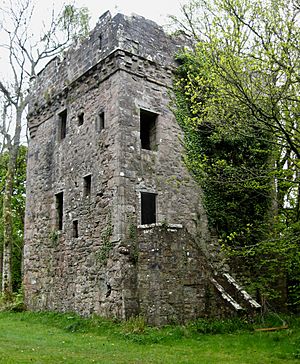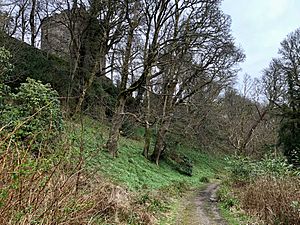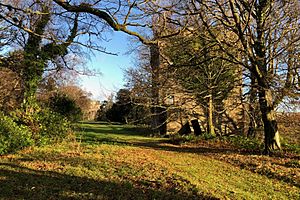Ardgowan Castle facts for kids
Quick facts for kids Ardgowan Castle |
|
|---|---|

Ardgowan Castle entrance stair
|
|
|
Listed Building – Category B
|
|
| Designated | 10 June 1971 |
| Reference no. | LB13642 |
| Lua error in Module:Location_map at line 420: attempt to index field 'wikibase' (a nil value). | |
Ardgowan Castle, originally called Inverkip Castle, is an old ruined castle in Scotland. It's found on the huge Ardgowan House estate, close to the town of Inverkip. This castle is near the Firth of Clyde, a large sea inlet, in an area called Inverclyde. It's a three-story ruin from the 1400s and is protected as an important historical building.
Where is Ardgowan Castle?
The castle sits on a high piece of land that sticks out. It's about 60 feet (18 meters) above the flat coast. This spot has steep sides, like cliffs, making it a great place for defense. Long ago, a watch tower stood here to look out for Viking raiders. Later, Inverkip Castle became a key fortress in the Middle Ages.
A Look Back: Castle History
Ardgowan Castle, then called Inverkip Castle, played a part in the First War of Scottish Independence. In 1301, King Edward I of England sent two armies into Scotland. His plan was for them to meet at Inverkip. But the armies ended up meeting somewhere else.
In 1302, Robert the Bruce agreed to be loyal to King Edward of England. In 1303, Bruce helped Edward's forces. They attacked Rothesay Castle and then surrounded Inverkip Castle. By early September, they had captured both castles. Robert the Bruce is said to have helped take Inverkip Castle. He then had to move large siege engines north. These were used to attack Stirling Castle.
In 1306, a Scottish knight named Sir Adam Gordon held Inverkip for King Edward. Around March, supporters of King Robert the Bruce attacked the castle. They were led by Robert Boyd of Cunningham.
Later that year, after a battle, King Edward ordered that Sir Thomas Randolph be held prisoner at Inverkip Castle. He was watched by Sir Adam Gordon. By September 1307, Sir Thomas was set free.
In 1307, Sir James Douglas, a friend of Robert the Bruce, defeated Sir Philip Mowbray. Sir Philip escaped to Inverkip Castle. The castle was full of English soldiers who welcomed him. Later, these English soldiers escaped from the castle by sea.
The Ardgowan Estate
In 1403, King Robert III gave the lands of Ardgowan to his son, Sir John Stewart. Ardgowan Castle, which is now a ruin, was built inside the older castle's site. It was built in the late 1400s. It sits on the south edge of the high land, right on a cliff.
In 1667, Archibald Stewart became a baronet, which is a special title. In 1730, the 3rd baronet married Helen Houston. Their son, Sir John Shaw Stewart, decided to build a new house. He hired an architect named Hugh Cairncross to design Ardgowan House. Building started in 1797 and finished around 1801. After that, the old castle was left to become a ruin. In 1936, the ruined castle was fixed up and made stronger.



